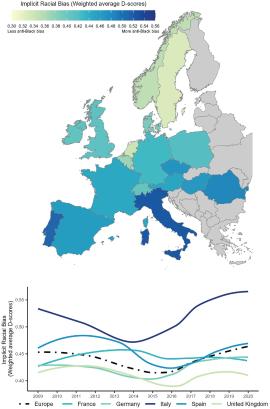
We are used to comparing countries in their levels of income inequality, unemployment or school results. But what about racism? We barely know which country is more or less racist than others. There is a remarkable reluctance among scientists to profoundly tackle this question.
As a first – and very partial – answer to this question, Kasimir Dederichs (Oxford University) and Pieter-Paul Verhaeghe (BRISPO) looked into the aggregated patterns of implicit bias against black people across countries. In this endeavour, we followed the Bias-of-crowds theory and the sociological framework of new institutionalism.
Implicit bias is stronger in southern and eastern vis-à-vis northern and western European countries. It decreased until the mid-2010s but started to increase thereafter. The highest levels of bias are observed in Italy, Portugal, and Romania and the lowest in Sweden, the Netherlands and Norway. Our findings are recently published in the Socius journal.
This paper is of course still very descriptive and focusses on only one indicator of racism. The study is part of a larger research program in which Prof. Pieter-Paul Verhaeghe aim to examine and explain structural racism in Europe.
Full reference: Dederichs, K., & Verhaeghe, P.-P. (2024). Implicit Racial Bias in Europe: Cross-National Variation and Time Trends. Socius, 10. https://doi.org/10.1177/23780231241291131
